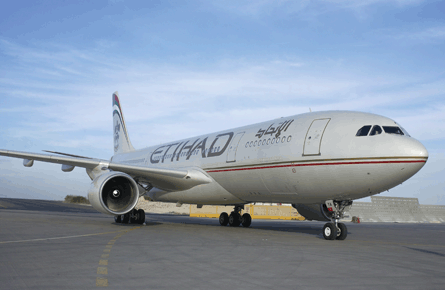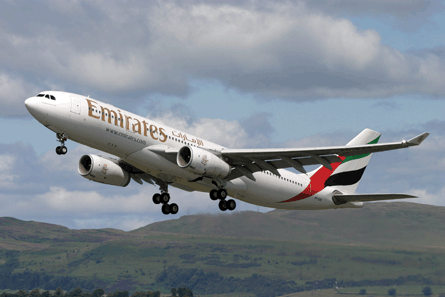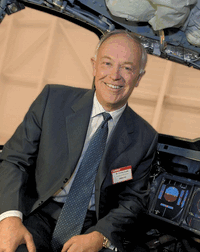Amid the worst global downturn in modern times, one region has stood out as a pillar of strength where the flag-carrier airlines have stuck with growth plans and added new aircraft galore.
Over the past 10 months, as the major airlines in Europe, Australasia, the Pacific Rim and the Americas have put their brakes on fleet expansion amid serious falls in passenger demand and yields, Emirates, Etihad Airways and Qatar Airways - the flag carriers of Dubai, Abu Dhabi and Qatar respectively - have carried on their breathtaking fleet and network growth.
Between them the three airlines have already introduced more than 20 new widebodies this year, with at least 10 more to come before 2009 is out. Meanwhile, a major new low-cost carrier has also launched operations from Dubai.
The Gulf may appear to be the region that defies the laws of gravity, but it has not been all plain sailing. The airlines all confess to suffering serious yield problems, which have seriously dented their revenues. Dubai in particular - so long the powerhouse of the region - has had to rein in its ambitions for an all-new global hub and is focusing on growing its airport Dubai International.
 |
|---|
© EtihadAfter adding 11 new aircraft in 2009, Etihad enters a period of consolidation next year |
"This year has been tough because income levels and yields per RPK are down. But that is about one of the only negative signs we have," says Emirates Airline president Tim Clark.
 |
|---|
"Competition is getting very aggressive, just to keep passenger numbers"Akbar Al BakerChief executive, Qatar Airways |
Etihad boss James Hogan says that his airline has not escaped the gloom either, suffering the "double whammy" of the tough economic cycle and the swine flu pandemic, but has still continued with the planned introduction of 11 new aircraft. "We're an industry that is used to shocks - last year we had to absorb the fuel price and focus on our costs. This year has been unusual - we've had the recession and the pandemic."
Akbar Al Baker, chief executive of Qatar Airways, says it has been "a very unlucky and unprecedented two years" for the industry. "First the oil price inflation, then the financial crisis then H1-N1 [swine flu]," he says.
Emirates is the oldest and biggest of the region's global network carriers, having launched in 1985 and carried 22.7 million passengers in 2008 - more than its two local rivals combined. The airline, which took over the mantle from the Middle East's previous standard bearer Gulf Air a decade ago, boasts an all-widebody passenger fleet that totals 130 aircraft, and a network of more than 100 destinations.
Qatar Airways, which launched its current guise in 1997 with Al Baker at the helm, carried in excess of 12 million passengers in its 2008-9 financial year and has a fleet of almost 70 aircraft.
Abu Dhabi, like Qatar, was once a member of the Gulf Air consortium, but pulled out to focus on its own airline, Etihad. Set up just five years ago, Etihad may be the baby of the bunch but carried six million passengers in 2008 and expects to grow to nine million this year. By the end of the year its route network will comprise 57 points and its fleet 50 aircraft, which like Qatar Airways, is a mix of single-aisle and widebodies. Hogan took the helm in October 2006, having previously been head of Gulf Air in Bahrain.
 |
|---|
© Qatar AirlinesQatar Airways uses its expanding 777 fleet to add new, far-flung points to its network |
None of the carriers has backed off in the face of the economic downturn. As Hogan points out, data from the International Air Transport Association shows that traffic during the first eight months of 2009 in every region has been in decline, except one - the Middle East.
"This region has outperformed the industry every month since January on RPKs, seat factor, etc," he says. However, he adds that the downside to the region's apparent resilience is that competitors from other areas have been "focusing on this part of the world".
Al Baker says that Qatar Airways, which is adding aircraft at a rate of more than one a month, is "not going to stop our growth plans. We still have a lot of traffic rights we can utilise."
It is the same story at Emirates, where "our growth, in terms of aircraft induction, continues apace", says Clark. "Passenger growth is running at around 18% over this time last year."
However, the turmoil of 2008 has taken its toll on the airline, which suffered an 80% fall in net profits to 982 million dirham ($268 million).
Despite the downturn, the Dubai carrier has "stuck to its guns", retaining its plan to take 22 widebodies in the current financial year, which ends on 30 March 2010. The airline has five A380s in service, with a sixth due to arrive this month.
 |
|---|
© EmiratesEmirates' A330-200s will begin departing the fleet in September 2010 |
"We've got 10 to come by the summer of next year," says Clark, although he adds the caveat that the deliveries still suffer "niggling delays", which makes longer-term planning problematic. "Beyond next summer we're keeping our fingers crossed [on the A380 delivery schedule]," he says.
On top of the A380 influx, Emirates is adding one Boeing 777 a month so that by the summer of 2010 its passenger fleet will be up to about 145 widebodies.
From September 2010, Emirates will begin to roll over some of its older aircraft, beginning with its A330-200s, the oldest of which have now been in the fleet for a decade. A total of 58 aircraft will gradually be replaced, including 29 A330-200s, eight leased A340-300s and 21 777 Classics.
Clark says he felt obliged to continue with new deliveries because the alternative - telling Airbus and Boeing he did not want to take the aircraft that were sitting on the ramp in Toulouse and Seattle - would "push half the aerospace industry out of work. We had a legal - almost moral - obligation to the supply chain to continue what we were doing."
Emirates decided it would "tough it out" and keep growing, with the prerequisite that it must "stay in the black, cash positive, and the brand and product in good shape". But Clark confesses that adopting this strategy in the early days of a downturn in the absence of any firm economic data can be risky.
 |
|---|
"Last year, nobody knew what was going on, and everybody lost their nerve"Tim ClarkPresident, Emirates Airline |
But while passenger volumes have remained strong, "it's what the passengers are paying us that is a problem", says Clark.
Qatar Airways has faced similar problems, says Al Baker. "Our biggest challenge is holding our yield. There is a downward pressure because our competition in the region is getting very aggressive, just to keep passenger numbers without looking at the bottom line, which is a very foolish way of conducting business," he says.
The airline will have introduced around a dozen new aircraft during 2009 and next year will take nearly 20 new 777s (including its first two 777 Freighters). These aircraft will be for expansion, either going on to new routes (Sydney and its first South American destination, São Paulo, are among the plans for 2010) or replacing A330s on existing routes and allowing the Airbus twinjets to be redeployed. It is also adding new A320s and A321s, equipped with a new generation of seats and in-flight entertainment.
Like its neighbours, the bulk of the 160 aircraft Qatar Airways has on order are widebodies. These include both next-generation twin-aisles, the 787 and A350, for delivery from 2011 and 2013 respectively, as well as five A380s, which are due to start arriving four years from now. Although not all the aircraft are for growth, Al Baker says the airline "will not start replacing the current fleet before 2011 or 2012".
The airline serves 82 destinations and has added three new routes this year, with its first Australian destination, Melbourne, coming on line in December. While traffic using the airline's Doha hub from Europe is key to this new market, Al Baker says he is also targeting local business. "There is a lot of demand from our region," he says.
Etihad's ambition is to carry nine million passengers this year, putting it 16% up on 2008. However it will then begin "a degree of consolidation", says Hogan. The airline has added 11 aircraft this year, including A320s, A330/A340s and a 777, but will take just four aircraft next year and "three or four" in 2011. "Then at the back end of 2012 we start to receive the first of the 100 aircraft we ordered at Farnborough last year through to 2017."
The first of 10 A380s are scheduled for 2012. "These had been due to arrive now, but in early 2007 we pushed them back because we were concerned we'd be adding too much capacity too soon."
The airline is riding the boom in its hometown, "which has stayed open for business in the downturn" and which accounts for 52% of its traffic, says Hogan. "That's a reflection of what's happening here. Over the next seven years, as part of Abu Dhabi's '2030 plan' there are ongoing projects that add up to $200 billion - these include the Yas Marina Formula 1 race track, infrastructure, light rail, hospitals schools etc. At the same time, more and more companies are coming and setting up their businesses in the capital."
The same is true of Qatar's capital Doha, which is undertaking major development projects and will have a brand-new international airport within four years. The country is also flush with the revenue from its huge natural gas reserves, and aims to become the world's capital for gas-to-liquid petroleum production.
Clark concedes things have not been so rosy in Dubai, which was until recently the region's commercial Mecca. Although Emirates has always had its hub-and-spoke network at the centre of its business strategy, it found that during the boom times, Dubai's origin and destination traffic had been so lucrative that it tweaked is strategy. "The premium cabins had been generating yield levels that I never thought I'd see in my career", says Clark. "So we turned off other parts of the business."
But this lucrative O&D traffic began to diminish in 2008 as Dubai's real estate and financial services businesses "started taking a pasting", says Clark, and the airline focused more on its transit business. The effect was that "the number of people travelling in business and economy declined by 3-4 percentage points, but yield went down further because they were paying less".
Etihad saw strong yield growth until 2008, but this year it has declined in some segments back to 2007 levels, says Hogan. And global economic gloom aside, he points to the swine flu pandemic as being harmful to its local business. "Middle East traffic is down 36% this year. People in the region didn't travel, and the home market is normally the higher yielding market, which has put all the airlines in the region under pressure," he says.
Al Baker agrees on the effect of swine flu. "The H1-N1 pandemic has put undue pressure on the airline industry because a lot of people have decided not to travel".
 |
|---|
"This year has been unusual - we've had the recession and the swine flu pandemic"James HoganChief executive, Etihad Airways |
Hogan says that while Abu Dhabi's inbound loads have remained strong, outbound traffic "hasn't been where it was in previous years", but he is confident that business will be back next year.
The effects of the downturn and the pandemic meanunit fares have declined due to discounting to stimulate traffic. Hogan also thinks the timing of the A380's arrival has not helped the industry's overcapacity problem. "If ever there was a time not to get A380s, it was right now," he says.
Clark wonders whether the industry overreacted in the early part of the year and cut prices too far. "At the end of last year, nobody knew what was going on, and everybody lost their nerve. Maybe history will say we beat ourselves up too soon on this. I've been leaning heavily on our pricing and we've seen a 22% increase in prices in the past five months - and we've still got high seat factors."
The yield declines this year mean that Etihad will struggle to achieve its revenue target, says Hogan, and this has been compounded by the fact that the airline has been growing its route network with seven additions in 2009. "The normal rule of thumb is that it takes three years to get to breakeven."
This means it will get be tough to reach the target of breaking even in 2010. "We've got a three-year rolling plan and I've got one challenge - revenue. Everything else is under control and positioned to accelerate."
Al Baker says that despite the woes, Qatar Airways has been "very profitable" in three of the five months of its current financial year, which began on 1 April. However, he does not project what the impact of the downturn will have on the airline's full-year performance.
Cargo is an important part of all three airlines' businesses (they all operate widebody full-freighters), so the collapse of that market has added to their woes. Cargo volumes were 35-40% down at the beginning of this year, and yields fell dramatically, says Clark. "We dealt with the collapse very quickly by selling our two A310 freighters. And fortunately deliveries of our 747-8Fs have been delayed due to the programme slip."
However, the airline went ahead with the introduction of new 777Fs as planned and now has two in service.
Qatar Airways Cargo operates three A300-600 dedicated freighters and Al Baker says that although the market has been "down big time with some people" the airline is "still doing well" as its exposure is limited. "Having a small fleet, we can very quickly move capacity to where there is demand."
The first two 777Fs arrive in 2010, by which time Al Baker expects the market to have rebounded, he says. "I'm also expecting that having large volume freighters will enable us to capture a large amount of market that currently goes to other airlines."
Etihad's freight arm, Crystal Cargo, has a couple of A300-600Fs, and in August next year will be the first airline to take the new 64t payload A330-200F. "We're starting to see cargo come back," says Hogan.
All the airlines have sought to offset their revenue shortfalls with better cost control. For Emirates and Etihad in particular this has meant a recruitment freeze, although both are beginning to thaw.
At Emirates, this entailed "tending to the house and cleaning it up", says Clark. "In recent years we'd been chasing our tails trying to meet the demand and we'd lost sight of what we should have been doing in the company improving our processes in the electronic age. It wasn't about cutting jobs, but about stopping recruitment and letting attrition take its natural course."
Hogan says Etihad's youth gives it the advantage of starting with a clean sheet of paper. "We're a 'new-wave' carrier without the burdens of a legacy carrier, and we're not subsidised," he says, adding that much of the business's needs are outsourced, meaning there are not unwieldy "legacy" departments in-house dealing with areas such as IT and so on.
As part of Emirates' cost drive, Clark says that the 2009-10 budget had a "zero base - meaning anything that anybody wanted had to be signed off by me, and that got everyone thinking".
Clark hopes the airline will get close to his 16% unit cost reduction target for the current financial year. "We'll be 12% down - hopefully a bit more. This will mean that costs at the end of the year will be flat or down a bit, despite our 14% fleet growth. And when we grow next year, I expect the costs to come down again."
With Etihad poised to ride the recovery wave, Hogan awaitsthe "famous green shoots". He says: "It's like surfing: waiting for the wave. As the market turns, Etihad is in great shape to accelerate. People have to travel to do business. The market,at some stage, corrects."
Clark does not share the view of carriers from other regions that the world's air travel market is in "total collapse, that there has been a paradigm shift in the global economy and that there will never be any more business-class passengers".
While he accepts that the world is "resetting to 2002-3 and growing at about 2-3% [gross domestic product]" a year, Clark believes that the world's population remains "aspirational".
Clark says that while "people have reset to the way things are now - they definitely tasted the good life, and one way or another they'll want to get back there".
So given the clear determination of the Gulf's three well-funded and ambitious global airlines, the legacy network carriers will face an ever greater challenge to retain their hub traffic as the market recovers.
VIDEO: See our interview with Ghaith Al-Ghaith, CEO of Dubai based low cost carrier FlyDubai in our Gulf low-cost market special
Source: Flight International
















